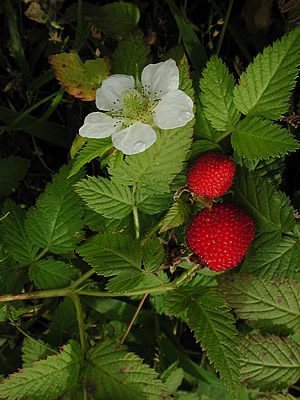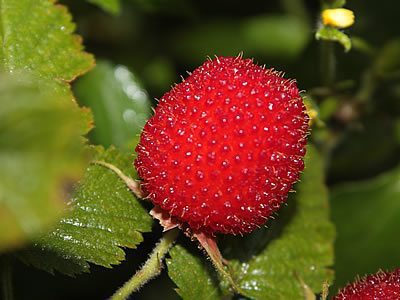The Roseleaf Bramble (Rubus rosifolius) is a shrubby, fruit-bearing plant. Although many may think it is native, it actually originates from Africa, Asia, and Oceania. In many places the species has become naturalized, appearing spontaneously on the edges of forests and humid woodlands in localities with moderate altitude. It is an erect to prostrate shrub that reaches from half a meter to two meters in height, generally forming large clumps. The branches are branched, sparse, and covered with sharp aculei.
The leaves are pinnate, with seven ovate, acuminate, rough, membranous leaflets, with serrated margins, glandular hairs, and a bright green color. It flowers and fruits during the fall and spring, displaying small white, pentamerous flowers in the terminal axils. The fruits are a type of apocarpous drupe, small, soft, and brightly red when ripe.
They are hollow, sweet, and slightly acidic and can be consumed in natura, or in the form of sweets, jellies, compotes, wines, liqueurs, yogurts, smoothies, fillings, pavlovas, juices, and ice creams. The small fruits are also very attractive to birds. There is also a variety of yellow fruits.

A shrub that is not only ornamental but also delights children. Don’t be surprised if it appears in your garden. This species is invasive and spreads very easily through the action of birds. We should enjoy the harvest of fruits that insist on appearing daily. Use them in your recipes and help nature by being diligent with watering and fertilization. Despite being rustic, you can increase the The productivity of the roseleaf bramble with care such as pruning, fertilization, and supplementary irrigation.
The roseleaf bramble should be cultivated in full sun or partial shade, in any type of soil from sandy to clayey, but preferably deep, enriched with organic matter and irrigated regularly. It prefers the mild climate of subtropical regions, not tolerating excessively dry and hot climates. It is advisable to renew plantings every three years to recover the vigor of the plants with the formation of new roots.
Pruning also stimulates good fruiting and should be carried out at the end of winter, eliminating the branches that have fruited, as well as dry, diseased, and poorly formed branches. Fertilize throughout spring and summer with composted manure, bone meal, and ashes. Cover the soil with a generous layer of dry leaves or other mulch. It multiplies easily by seeds, division of rooted branches, cuttings, layering, and sprouts that emerge directly from the roots.

